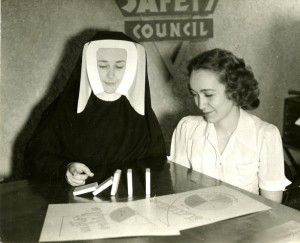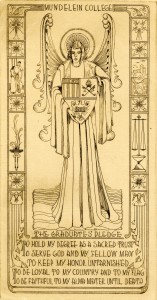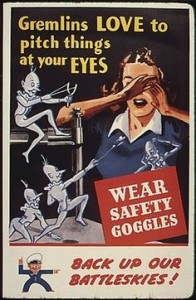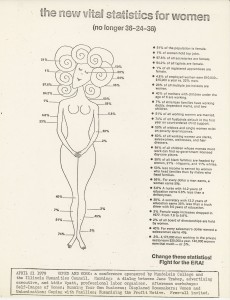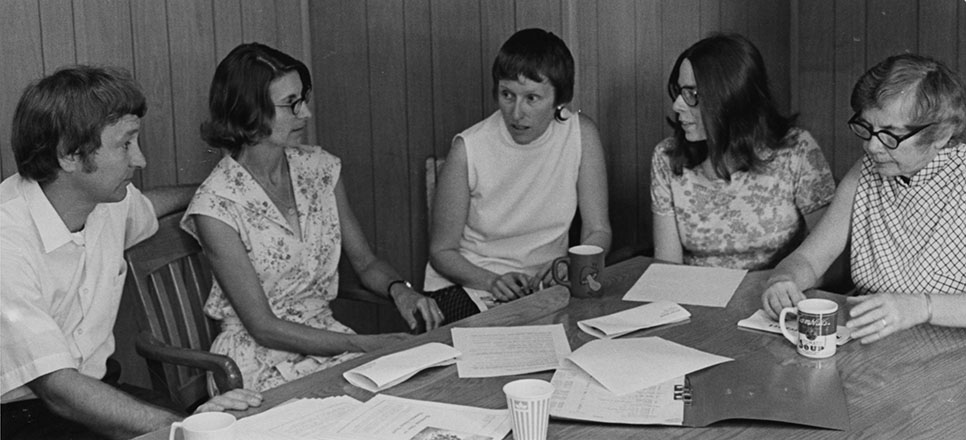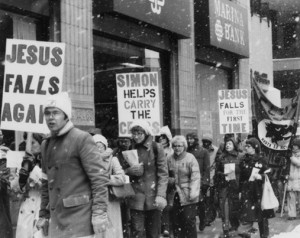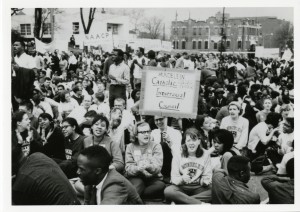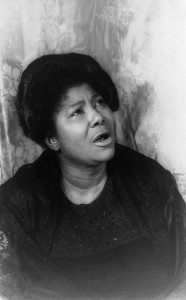As part of our Women’s History Month activities, I worked on creating a display showcasing materials from the collection of Mundelein College, a Catholic women’s college that was once located next to Loyola. The exhibit focused on two of Mundelein’s art professors and two students who went on to have successful art careers. This was another great opportunity to find new things and learn more about life at this unique college for women.
As I researched the art professors of Mundelein, I found interesting details on the life of Sister Mary Carmelyn. Sister Mary Carmelyn McMahon was born in Missoula, Montana in 1905 and taught at Mundelein from 1934 to 1954. Sister Mary Carmelyn designed several of the college’s Christmas cards and even illustrated the Graduate Pledge, which was taken by seniors at every commencement ceremony.
While inspiring students in her role as a teacher, Sister Mary Carmelyn discovered something else about which she was passionate. She began the College Safety Council at Mundelein in 1943 and spent her time learning and sharing ways to prevent accidents on school campuses and beyond. In the 1940s, she dedicated much of her time to the Red Cross and was appointed to serve on many safety councils, including the Education Committee of President Truman’s Conference on Highway Safety. She even taught the other BVM’s to swim. I wish we had a photo of that to share!
This sudden concern for accident prevention seems out of the blue, but Sister Mary Carmelyn was actually just doing her patriotic duty. In the midst of World War II, factories increased production to provide supplies. Meanwhile, workplace accidents and injuries also increased. The National Safety Council, with the support of President Roosevelt, launched a national campaign in 1941 to teach ways to avoid accidents in industries, homes, schools, and on the road. Citizens could support the war effort by preventing carelessness that would waste resources or result in injury to much needed workers.
Sister Mary Carmelyn participated in the movement that spread these safety lessons to all areas of life. She promoted the 3 E’s of accident prevention: Education, Engineering, and Enforcement. She also wrote an article for Safety Education Magazine explaining the forgotten “R” in safety, religion. “Knowledge of skills,” Mary Carmelyn wrote, “plus the realization and acceptance of man’s relationship to his fellow men and his Creator, will…direct the knowledge toward…attitudes of safe living.”
Exploring Sister Mary Carmelyn’s records in the Mundelein College Collection provided the opportunity for me to learn more about national events during World War II. Through the archives, I was able to see one fascinating woman’s participation in broader patterns of history.
Caroline is a Graduate Assistant at the WLA and is working on her Master’s in Public History at Loyola University Chicago. She spends her spare time caring for her pufferfish, interpreting dreams, and watching cheesy movies.
Loyola University Chicago’s Women and Leadership Archives Blog is designed to provide a positive environment for the Loyola community to discuss important issues and ideas. Differences of opinion are encouraged. We invite comments in response to posts and ask that you write in a civil and respectful manner. All comments will be screened for tone and content and must include the first and last name of the author and a valid email address. The appearance of comments on the blog does not imply the University’s endorsement or acceptance of views expressed.


